About This Study
Every year, Carbon-Free Europe partners with Evolved Energy Research to create an Annual Decarbonisation Perspective (ADP) for the EU & UK. This study provides annual insights into Europe's progress towards carbon neutrality by using cutting-edge energy systems models to evaluate the latest changes in energy policy and technology costs. The Core pathway (one of five scenarios) is the least constrained due to its inclusion of all available clean energy technologies. This makes it the most feasible, cost-effective pathway to net-zero. The other four scenarios and seven sensitivities explore how different policy and implementation constraints impact the route to carbon neutrality. To learn more about the 2023 scenarios and sensitivities, see the appendix.
What shaped CFE's 2023 Annual Decarbonisation Perspective?
Russia's invasion of Ukraine shed light on Europe's energy dependence on Russian fossil fuels, resulting in an energy supply and price crisis. With increased pressure to accelerate the energy transition while also ensuring energy sovereignty, EU policymakers have now finalised most files within the Fit for 55 package and the Commission's REPowerEU plan. Meanwhile, in the UK, Prime Minister Rishi Sunak has prioritised stabilising the economy and combatting the energy crisis. These events drastically impacted 2022’s energy landscape, with these effects reflected in 2023’s analysis.
Takeaways
- Recent climate policy, including the Fit for 55 and REPowerEU, has laid the groundwork for the EU’s ability to quit Russian natural gas in the near term.
- Ukraine can become a unique contributor of both clean electricity and hydrogen to the rest of Europe, adding almost 100 GWs of new wind and solar by 2050, or almost 20% of today’s EU renewable capacity.
- Technology-inclusive policies decrease the EU’s dependence on energy imports.
- The EU will need to build new infrastructure–electricity grids, hydrogen pipelines, and CO2 pipelines–at unprecedented rates to sustain a clean energy economy, requiring faster siting, permitting, and financing of projects.
- It is imperative for the EU to facilitate near-term financing and RD&D support for innovative technologies necessary for long-term decarbonisation.
- Encouraging flexibility (e.g., through Electricity Market Design reform and updating rate design to account for system-wide costs) is critical to the reliable and affordable operations of a clean power grid.
- A technology-inclusive hydrogen strategy is integral to the EU’s decarbonisation plans.
- Some countries will max out the usage of their renewable resource potential, underscoring the importance of long-term planning for resource constraints and land availability.
- Member State National Energy and Climate Plan (NECP) revisions must incorporate data-based assumptions about the activities of surrounding regions.
- Our first-of-a-kind analysis, using climate-specific capital costs for direct air capture (DAC) technologies based on hourly operations, finds DAC technology is a competitive option against other negative emissions technologies.
Key Takeaways for Policymakers
1. Recent climate policy, including the Fit for 55 and REPowerEU, has laid the groundwork for the EU’s ability to quit Russian natural gas in the near term. Our incorporation of a physical representation of the gas system and new binding EU targets, as part of the 2023 data updates, enabled our modelling to show that the accelerated deployment of renewables, heat pumps, building retrofits, hydrogen, and biomethane, as well as some expansion of other pipeline imports and Liquified Natural Gas (LNG), allows the EU and UK to rapidly reduce Russian natural gas imports to zero by no later than 2025.
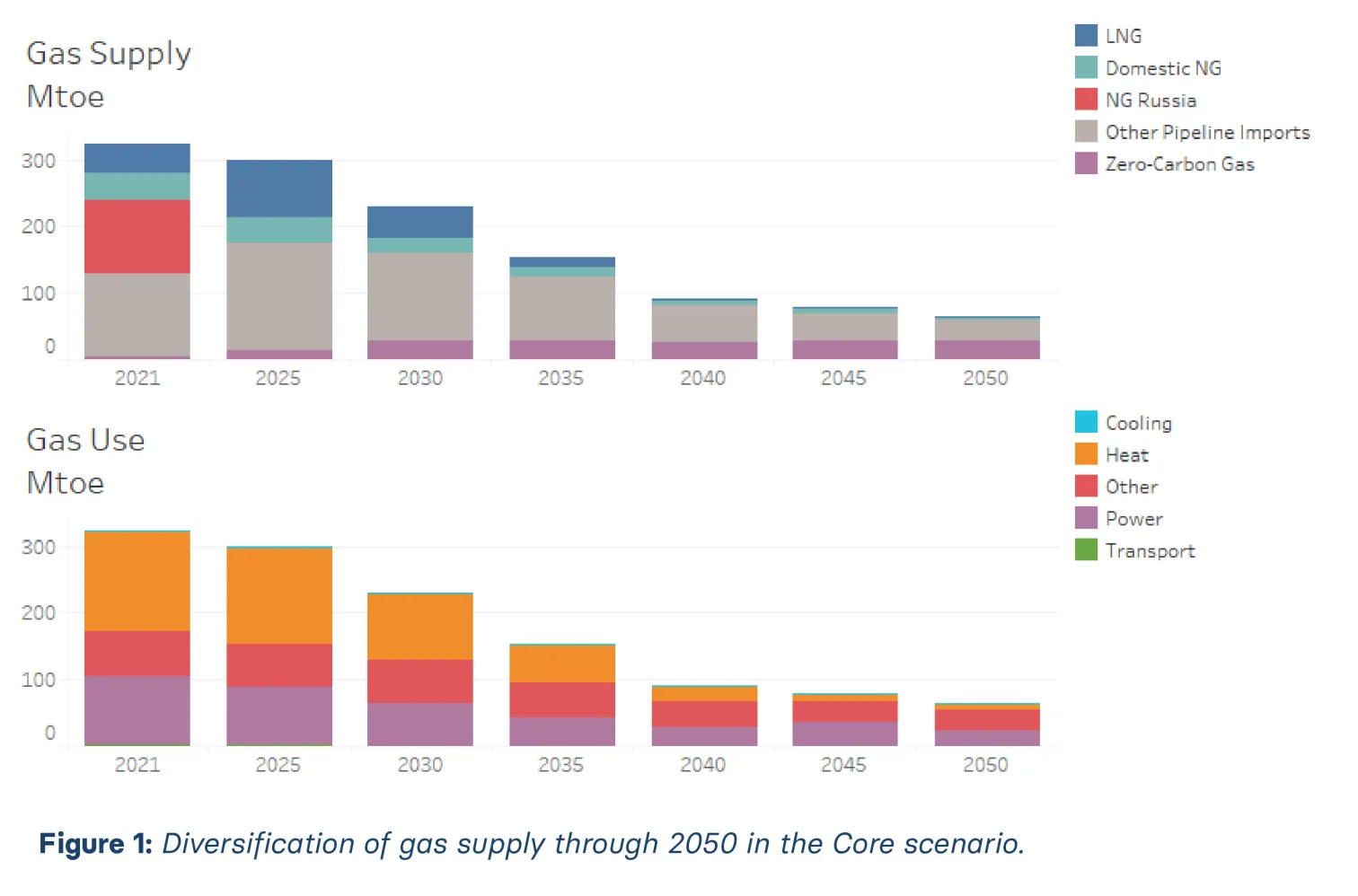 2. Ukraine can become a unique contributor of both clean electricity and hydrogen to the rest of Europe, adding almost 100 GWs of new wind and solar by 2050, or almost 20% of today’s EU renewable capacity. Due to Ukraine’s exceptional renewable resource potential, our model indicates that Ukraine can produce over 300 TWh of new renewable generation for the EU. This generation can convert into hydrogen, requiring a new hydrogen pipeline network, or in the form of electricity, requiring rebuilding damaged transmission lines to allow for Ukraine’s full integration into the EU grid.
2. Ukraine can become a unique contributor of both clean electricity and hydrogen to the rest of Europe, adding almost 100 GWs of new wind and solar by 2050, or almost 20% of today’s EU renewable capacity. Due to Ukraine’s exceptional renewable resource potential, our model indicates that Ukraine can produce over 300 TWh of new renewable generation for the EU. This generation can convert into hydrogen, requiring a new hydrogen pipeline network, or in the form of electricity, requiring rebuilding damaged transmission lines to allow for Ukraine’s full integration into the EU grid.
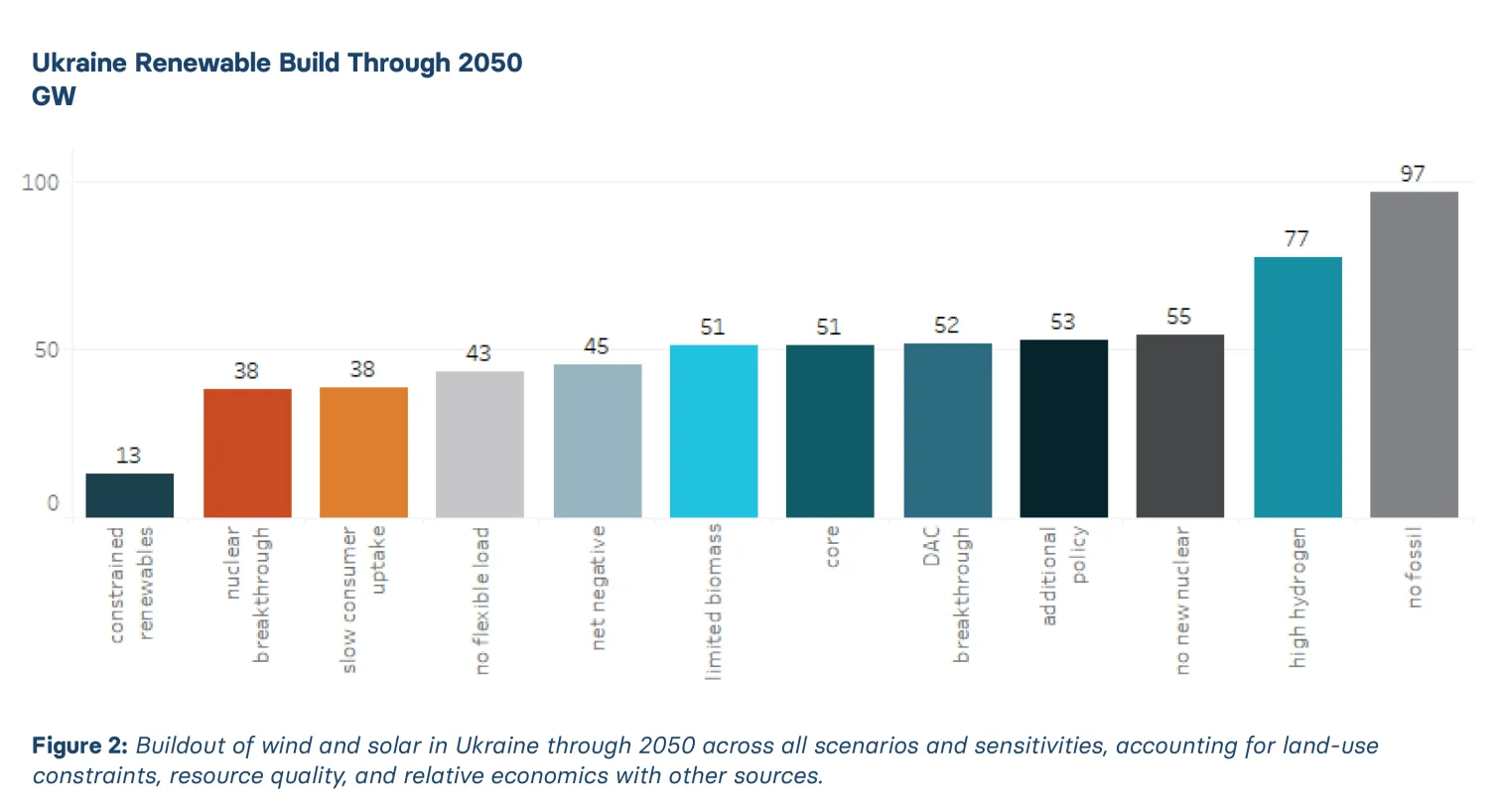
3. Technology-inclusive policies decrease Europe’s dependence on energy imports. In all modelled scenarios, most of the EU’s primary energy is produced within its borders, representing a significant shift from today. However, in the long run, the EU will remain reliant to some extent on energy imports in the form of hydrogen, zero-carbon fuels, and electricity. Scenarios with limited technology strategies (i.e., excluding carbon capture and storage, nuclear, biomass, etc.) result in larger amounts of imported primary energy. Therefore, policymakers will still need to prioritise energy security, including the amount of imported energy required and the location it is being exported from, to avoid becoming heavily dependent on one technology pathway or unreliable partners.
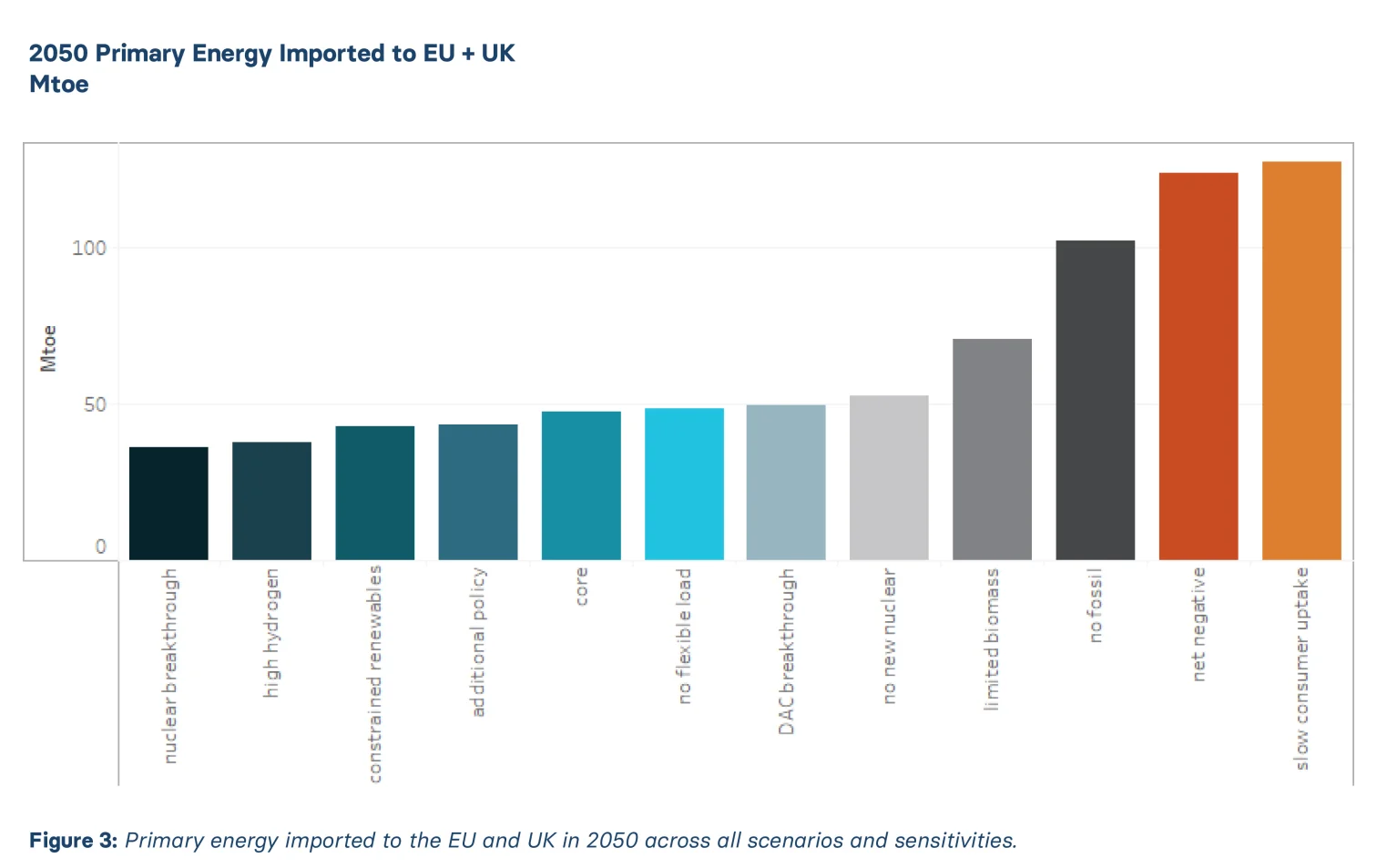
4. The EU will need to build new infrastructure–electricity grids, hydrogen pipelines, and CO2 pipelines–at unprecedented rates to sustain a clean energy economy, requiring faster siting, permitting, and financing of projects. Successfully planning out the integration of networked infrastructure is a key component of a decarbonisation plan, and therefore, the EU must strategically design these interconnections wisely. CFE’s model sees an increase of up to 170% in terms of inter-regional electricity connections, and the development of networks that can deliver up to 100,000 tonnes of H2 and 450,000 tonnes of CO2 daily across country borders.
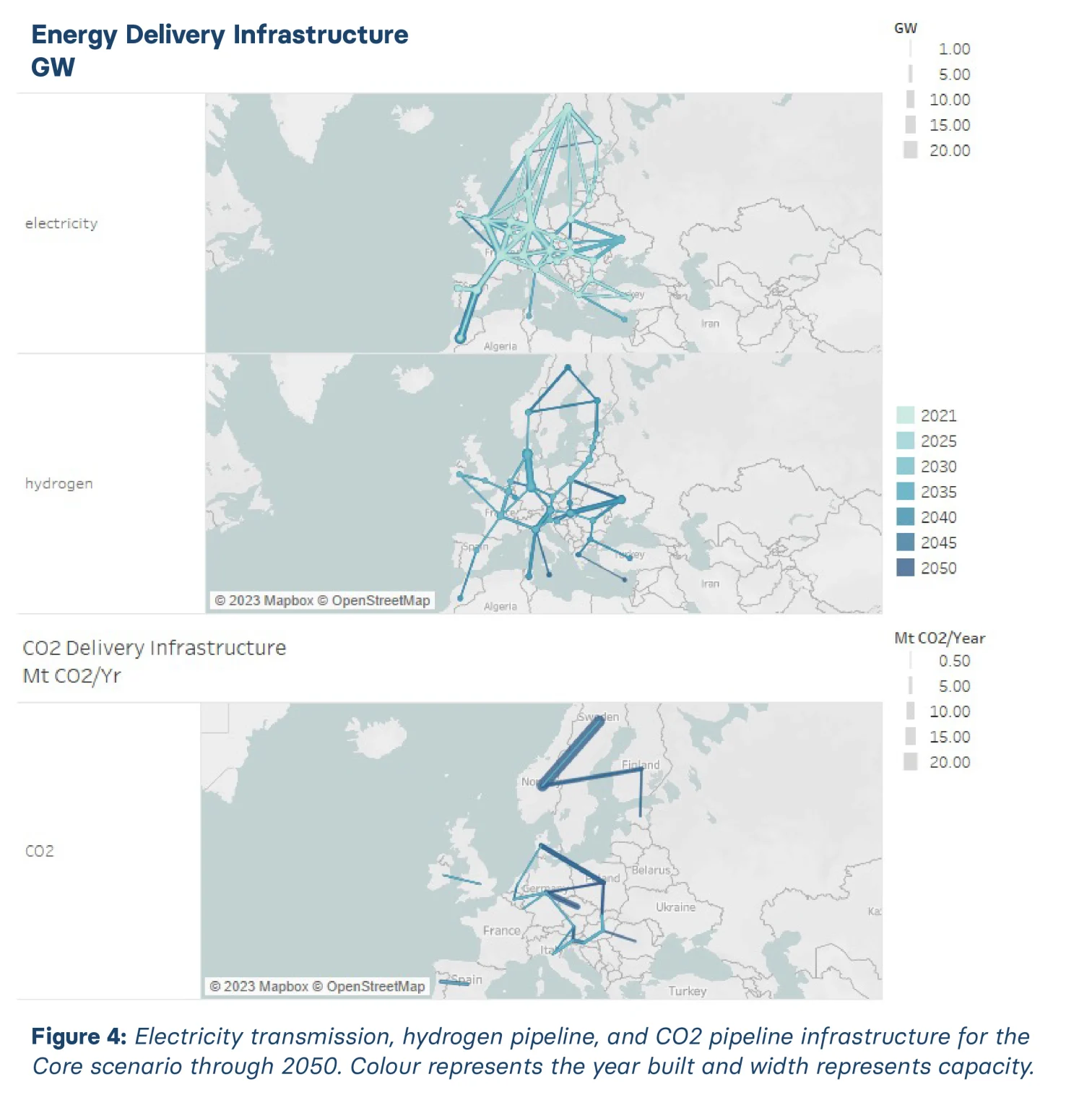 5. It is imperative for the EU to facilitate near-term financing and RD&D support for innovative technologies necessary for long-term decarbonisation.
5. It is imperative for the EU to facilitate near-term financing and RD&D support for innovative technologies necessary for long-term decarbonisation. Fully decarbonising by 2050 is a different challenge than meeting 2030 climate targets. Thanks to recent EU policies, like the Fit for 55 package, our modelling scenarios show broad agreement on the path to 2030. However, our scenarios diverge considerably by mid-century due to their distinct assumptions and limitations. To achieve a net-zero trajectory, policymakers must concentrate on near-term policies and the funding tools necessary to deploy key 2030 technologies like renewables, electric vehicles, and heat pumps, all while supporting technology research, development, and demonstration (RD&D) and policy frameworks that can contribute to “last mile” emissions reductions on a net-zero pathway.
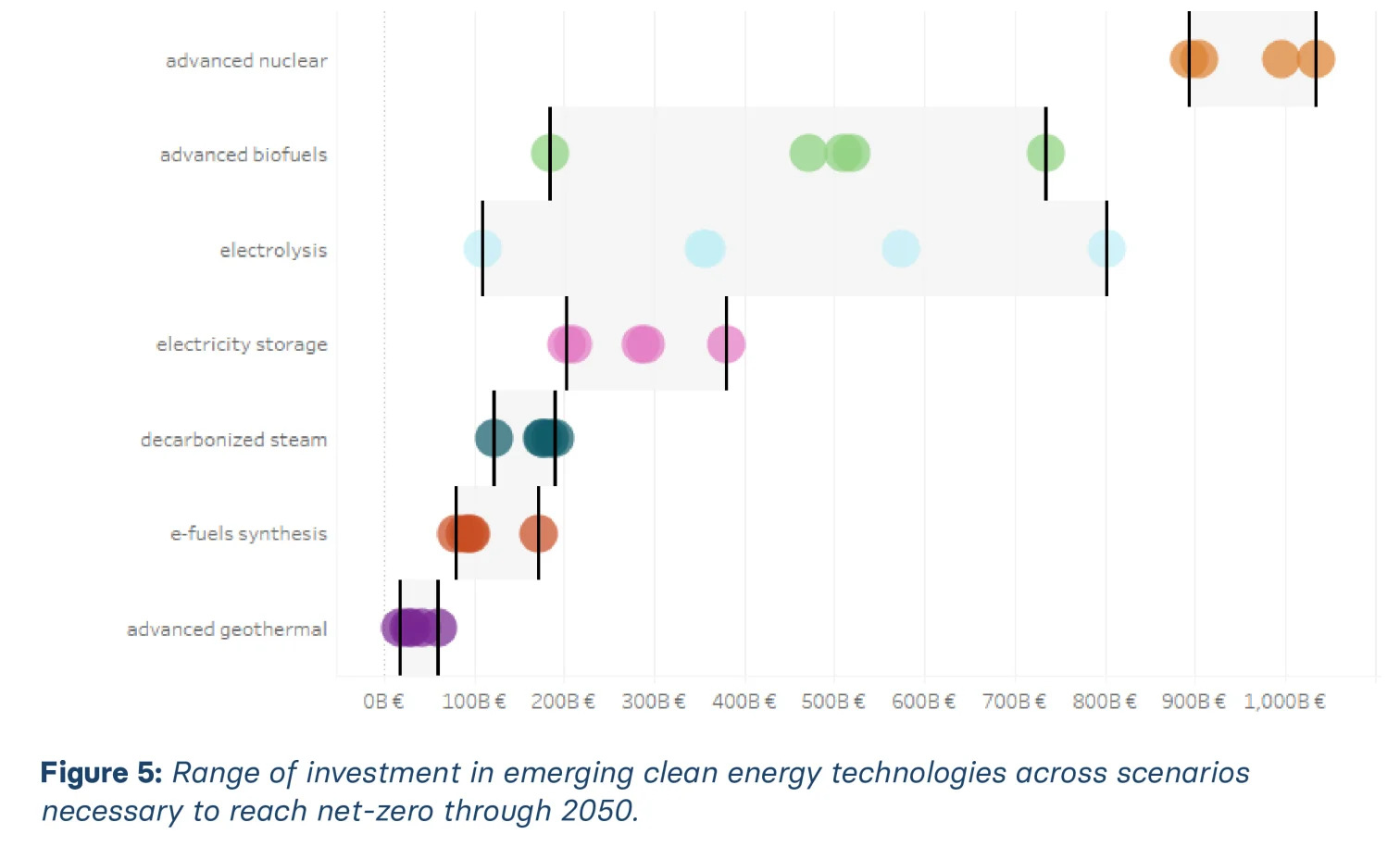 6. Encouraging flexibility (e.g., through Electricity Market Design reforms and updating rate designs to account for system-wide costs) is critical to the reliable and affordable operations of a clean power grid. This can decrease renewable curtailment by up to 150 TWh; increase the competitiveness of renewables against fossil alternatives; increases the competitiveness of hydrogen electrolysis and decarbonised industrial heat; and reduce the need to invest in other balancing solutions (batteries, thermal powerplants, etc.) and grid infrastructure.
6. Encouraging flexibility (e.g., through Electricity Market Design reforms and updating rate designs to account for system-wide costs) is critical to the reliable and affordable operations of a clean power grid. This can decrease renewable curtailment by up to 150 TWh; increase the competitiveness of renewables against fossil alternatives; increases the competitiveness of hydrogen electrolysis and decarbonised industrial heat; and reduce the need to invest in other balancing solutions (batteries, thermal powerplants, etc.) and grid infrastructure.
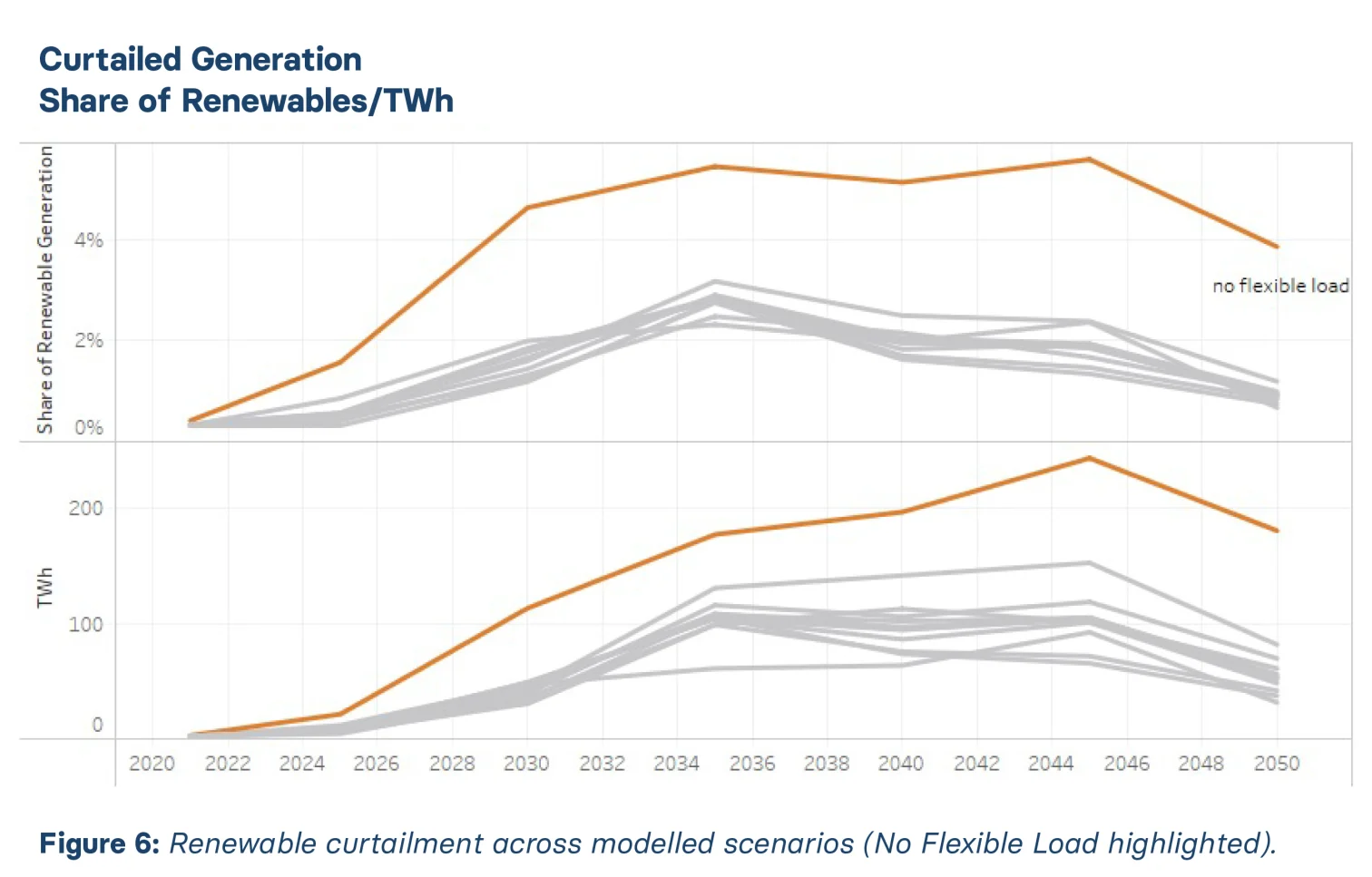 7. A technology-inclusive hydrogen strategy is integral to the EU’s decarbonisation plans.
7. A technology-inclusive hydrogen strategy is integral to the EU’s decarbonisation plans. As acknowledged through the EU Hydrogen strategy, hydrogen will play an essential role in deep decarbonisation as the EU electrifies its system and provides clean fuels for hard-to-electrify sectors. Low-temperature electrolysis, high-temperature nuclear electrolysis, and bioenergy with carbon capture and storage (BECCS) hydrogen can all contribute significantly to European hydrogen production. However, cost projections, overall projected demand, and the availability of renewables influence the relative shares of these hydrogen production methods. These three constraints underscore the importance of allowing all clean forms of hydrogen production to exist in a net-zero emissions system, enhancing resiliency.
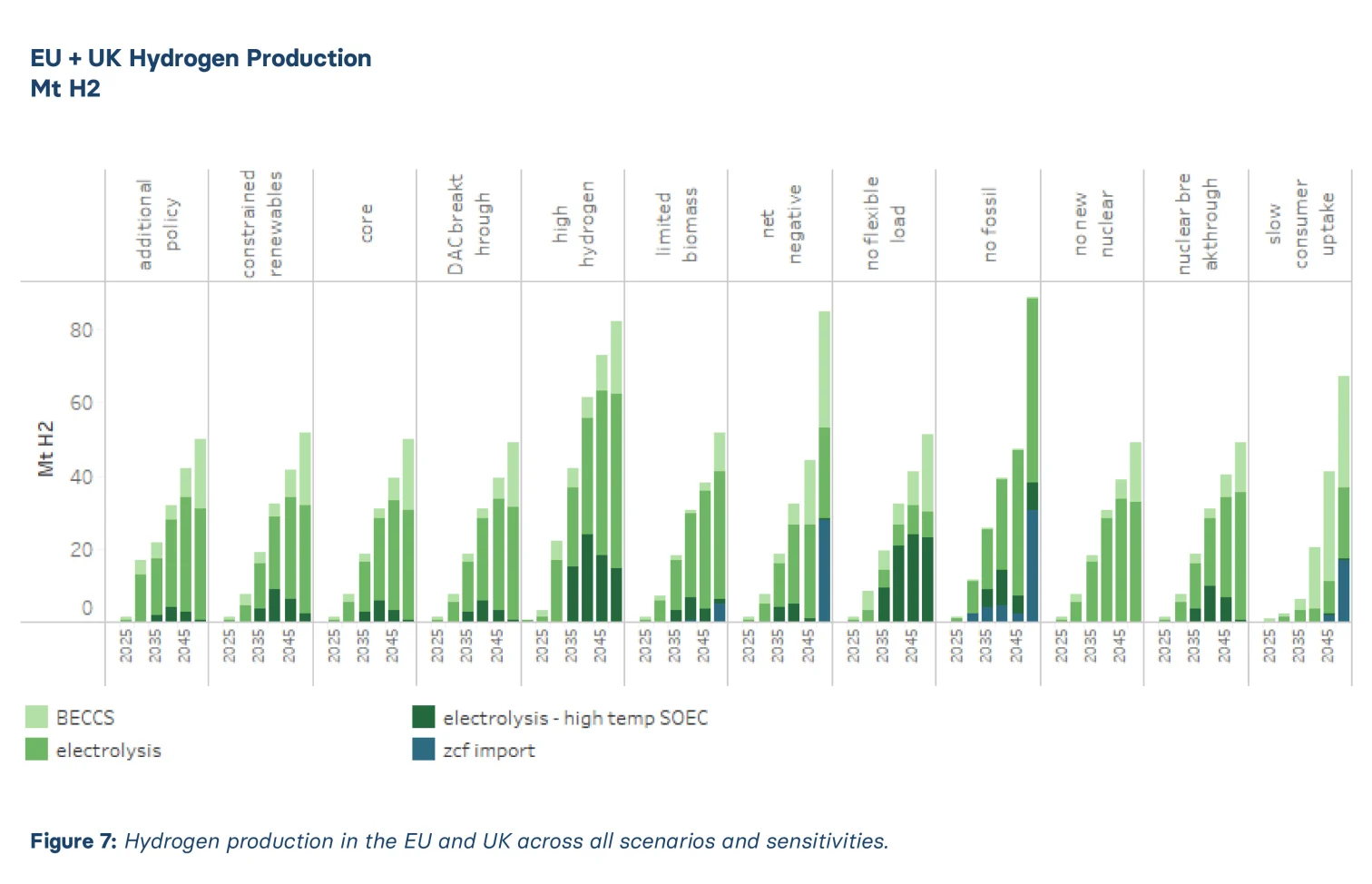
8. Some countries will max out the usage of their renewable resource potential, underscoring the importance of long-term planning for resource constraints and land availability. This finding reinforces the need for integrated network planning as well as supporting the development of alternative technologies. Despite not being competitive today against the lowest-cost wind and solar, in the long-term, we see the deployment of advanced nuclear, enhanced geothermal, and floating offshore wind technologies as research and deployment reduce technology costs, and these technologies reduce system-wide costs. This insight also offers a cautionary tale to Member States who choose to maintain or implement exclusionary clean energy policies. Not only is a tech-inclusive approach to net-zero more cost-effective, but it offers more energy independence as it mitigates the overreliance on imports.
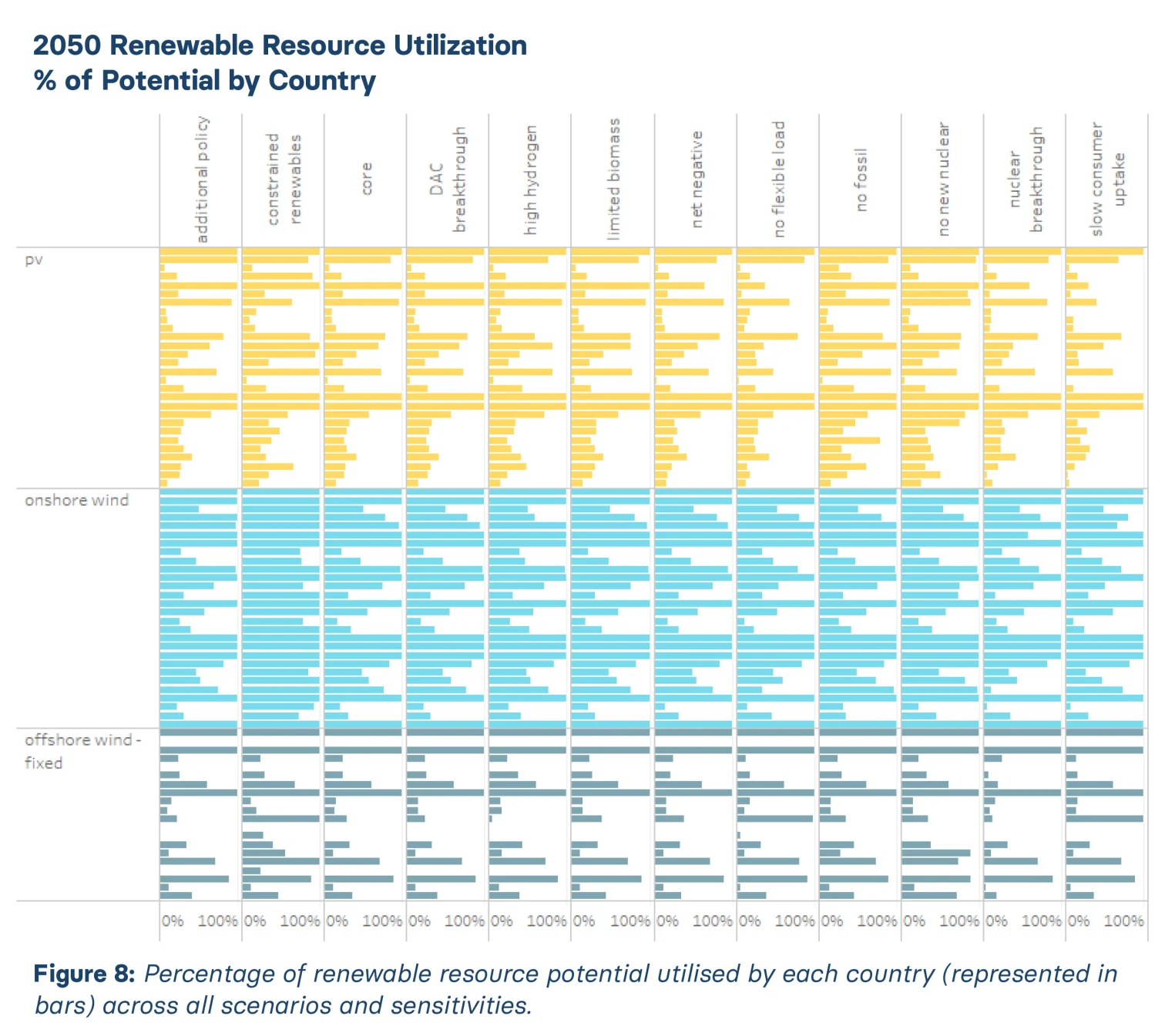 9. Member State National Energy and Climate Plans (NECP) revisions must incorporate data-based assumptions about the activities of surrounding regions.
9. Member State National Energy and Climate Plans (NECP) revisions must incorporate data-based assumptions about the activities of surrounding regions. Many of the most critical decarbonisation decisions a country makes are informed by the interconnections with its surrounding neighbours. This is true, most commonly for electricity, but also for deploying CO
2 pipelines and geologic sequestration; hydrogen production, pipelines, and storage; negative emissions technologies; and zero-carbon fuel production. Due to the importance of these cross-border interactions, a country’s net-zero trajectory cannot be understood or analysed in isolation. As Member States revise their National Energy and Climate Plans (NECP) and prepare for their final submission to the European Commission by 2024, it would be prudent for their planning to incorporate assumptions about the activities of surrounding regions.
10. Our first-of-a-kind analysis, incorporating climate-specific capital costs for Direct Air Capture (DAC) technologies based on hourly operations, finds DAC technology is a competitive option against other negative emissions technologies. DAC is particularly competitive where there are limited biomass supplies, cost breakthroughs, or increased climate ambition.
Appendix
 Sensitivities
Sensitivities begin with the
core scenario and determine the effects on the energy system of changing a single key variable. There are seven separate sensitivities, described in Table 2 below. Many of these relate to the readiness and expected cost of potentially important technologies (
nuclear breakthrough and
DAC breakthrough). Others relate to availability of key decarbonisation resources (
limited biomass and
constrained renewables) or policy questions (
no flexible load;
additional policy; and
net negative).


 2.
2. 

 5. It is imperative for the EU to facilitate near-term financing and RD&D support for innovative technologies necessary for long-term decarbonisation. Fully decarbonising by 2050 is a different challenge than meeting 2030 climate targets. Thanks to recent EU policies, like the Fit for 55 package, our modelling scenarios show broad agreement on the path to 2030. However, our scenarios diverge considerably by mid-century due to their distinct assumptions and limitations. To achieve a net-zero trajectory, policymakers must concentrate on near-term policies and the funding tools necessary to deploy key 2030 technologies like renewables, electric vehicles, and heat pumps, all while supporting technology research, development, and demonstration (RD&D) and policy frameworks that can contribute to “last mile” emissions reductions on a net-zero pathway.
5. It is imperative for the EU to facilitate near-term financing and RD&D support for innovative technologies necessary for long-term decarbonisation. Fully decarbonising by 2050 is a different challenge than meeting 2030 climate targets. Thanks to recent EU policies, like the Fit for 55 package, our modelling scenarios show broad agreement on the path to 2030. However, our scenarios diverge considerably by mid-century due to their distinct assumptions and limitations. To achieve a net-zero trajectory, policymakers must concentrate on near-term policies and the funding tools necessary to deploy key 2030 technologies like renewables, electric vehicles, and heat pumps, all while supporting technology research, development, and demonstration (RD&D) and policy frameworks that can contribute to “last mile” emissions reductions on a net-zero pathway. 6. Encouraging flexibility (e.g., through Electricity Market Design reforms and updating rate designs to account for system-wide costs) is critical to the reliable and affordable operations of a clean power grid. This can decrease renewable curtailment by up to 150 TWh; increase the competitiveness of renewables against fossil alternatives; increases the competitiveness of hydrogen electrolysis and decarbonised industrial heat; and reduce the need to invest in other balancing solutions (batteries, thermal powerplants, etc.) and grid infrastructure.
6. Encouraging flexibility (e.g., through Electricity Market Design reforms and updating rate designs to account for system-wide costs) is critical to the reliable and affordable operations of a clean power grid. This can decrease renewable curtailment by up to 150 TWh; increase the competitiveness of renewables against fossil alternatives; increases the competitiveness of hydrogen electrolysis and decarbonised industrial heat; and reduce the need to invest in other balancing solutions (batteries, thermal powerplants, etc.) and grid infrastructure. 7. A technology-inclusive hydrogen strategy is integral to the EU’s decarbonisation plans. As acknowledged through the EU Hydrogen strategy, hydrogen will play an essential role in deep decarbonisation as the EU electrifies its system and provides clean fuels for hard-to-electrify sectors. Low-temperature electrolysis, high-temperature nuclear electrolysis, and bioenergy with carbon capture and storage (BECCS) hydrogen can all contribute significantly to European hydrogen production. However, cost projections, overall projected demand, and the availability of renewables influence the relative shares of these hydrogen production methods. These three constraints underscore the importance of allowing all clean forms of hydrogen production to exist in a net-zero emissions system, enhancing resiliency.
7. A technology-inclusive hydrogen strategy is integral to the EU’s decarbonisation plans. As acknowledged through the EU Hydrogen strategy, hydrogen will play an essential role in deep decarbonisation as the EU electrifies its system and provides clean fuels for hard-to-electrify sectors. Low-temperature electrolysis, high-temperature nuclear electrolysis, and bioenergy with carbon capture and storage (BECCS) hydrogen can all contribute significantly to European hydrogen production. However, cost projections, overall projected demand, and the availability of renewables influence the relative shares of these hydrogen production methods. These three constraints underscore the importance of allowing all clean forms of hydrogen production to exist in a net-zero emissions system, enhancing resiliency.
 9. Member State National Energy and Climate Plans (NECP) revisions must incorporate data-based assumptions about the activities of surrounding regions. Many of the most critical decarbonisation decisions a country makes are informed by the interconnections with its surrounding neighbours. This is true, most commonly for electricity, but also for deploying CO2 pipelines and geologic sequestration; hydrogen production, pipelines, and storage; negative emissions technologies; and zero-carbon fuel production. Due to the importance of these cross-border interactions, a country’s net-zero trajectory cannot be understood or analysed in isolation. As Member States revise their National Energy and Climate Plans (NECP) and prepare for their final submission to the European Commission by 2024, it would be prudent for their planning to incorporate assumptions about the activities of surrounding regions.
9. Member State National Energy and Climate Plans (NECP) revisions must incorporate data-based assumptions about the activities of surrounding regions. Many of the most critical decarbonisation decisions a country makes are informed by the interconnections with its surrounding neighbours. This is true, most commonly for electricity, but also for deploying CO2 pipelines and geologic sequestration; hydrogen production, pipelines, and storage; negative emissions technologies; and zero-carbon fuel production. Due to the importance of these cross-border interactions, a country’s net-zero trajectory cannot be understood or analysed in isolation. As Member States revise their National Energy and Climate Plans (NECP) and prepare for their final submission to the European Commission by 2024, it would be prudent for their planning to incorporate assumptions about the activities of surrounding regions.
 Sensitivities begin with the core scenario and determine the effects on the energy system of changing a single key variable. There are seven separate sensitivities, described in Table 2 below. Many of these relate to the readiness and expected cost of potentially important technologies (nuclear breakthrough and DAC breakthrough). Others relate to availability of key decarbonisation resources (limited biomass and constrained renewables) or policy questions (no flexible load; additional policy; and net negative).
Sensitivities begin with the core scenario and determine the effects on the energy system of changing a single key variable. There are seven separate sensitivities, described in Table 2 below. Many of these relate to the readiness and expected cost of potentially important technologies (nuclear breakthrough and DAC breakthrough). Others relate to availability of key decarbonisation resources (limited biomass and constrained renewables) or policy questions (no flexible load; additional policy; and net negative).